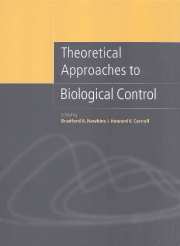Book contents
- Frontmatter
- Contents
- List of contributors
- Preface
- Part I Biological control theory: past and present
- Part II Ecological considerations
- 4 The uniformity and density of pest exploitation as guides to success in biological control
- 5 Biological control of insect pests: a tritrophic perspective
- 6 The case for indigenous generalists in biological control
- 7 Why is the parasitoid Encarsia formosa so successful in controlling whiteflies?
- 8 Parasitoid adult nutritional ecology: implications for biological control
- 9 Coexistence of multiple attractors and its consequences for a three-species food chain
- Part III Spatial considerations
- Part IV Genetic/evolutionary considerations
- Part V Microbes and pathogens
- Index
9 - Coexistence of multiple attractors and its consequences for a three-species food chain
from Part II - Ecological considerations
Published online by Cambridge University Press: 13 August 2009
- Frontmatter
- Contents
- List of contributors
- Preface
- Part I Biological control theory: past and present
- Part II Ecological considerations
- 4 The uniformity and density of pest exploitation as guides to success in biological control
- 5 Biological control of insect pests: a tritrophic perspective
- 6 The case for indigenous generalists in biological control
- 7 Why is the parasitoid Encarsia formosa so successful in controlling whiteflies?
- 8 Parasitoid adult nutritional ecology: implications for biological control
- 9 Coexistence of multiple attractors and its consequences for a three-species food chain
- Part III Spatial considerations
- Part IV Genetic/evolutionary considerations
- Part V Microbes and pathogens
- Index
Summary
Introduction
In this chapter we will consider the dynamics of a three-species food chain and the nature of the attractor relevant to this system. An attractor is a geometric object to which trajectories from a given initial state are attracted. For concretness, we may imagine an initial population size as representing an initial state. In the present case, the attractor serves as the final destination for the three trajectories that represent the three players in this drama. Knowledge of the nature of the attractor is crucial if biological control is to be successful: the attractor may be a fixed point as in the rest point of a pendulum, a regularly fluctuating cycle as in a heart beat, or some sort of aperiodic behavior. An important feature with which we will be concerned is the basins of attraction. The basins of attraction represent those collective points whose trajectories, after a period of elapsed time, end up on an attractor. Let us anticipate our discussion and mention at the outset that the attractors for this system are complicated. There may be coexisting chaotic and periodic attractors, or coexisting periodic attractors, depending on the initial conditions. Which attractor is the final destination of a trajectory depends intricately on the initial conditions, e.g., on initial population sizes.
- Type
- Chapter
- Information
- Theoretical Approaches to Biological Control , pp. 152 - 160Publisher: Cambridge University PressPrint publication year: 1999
- 1
- Cited by



